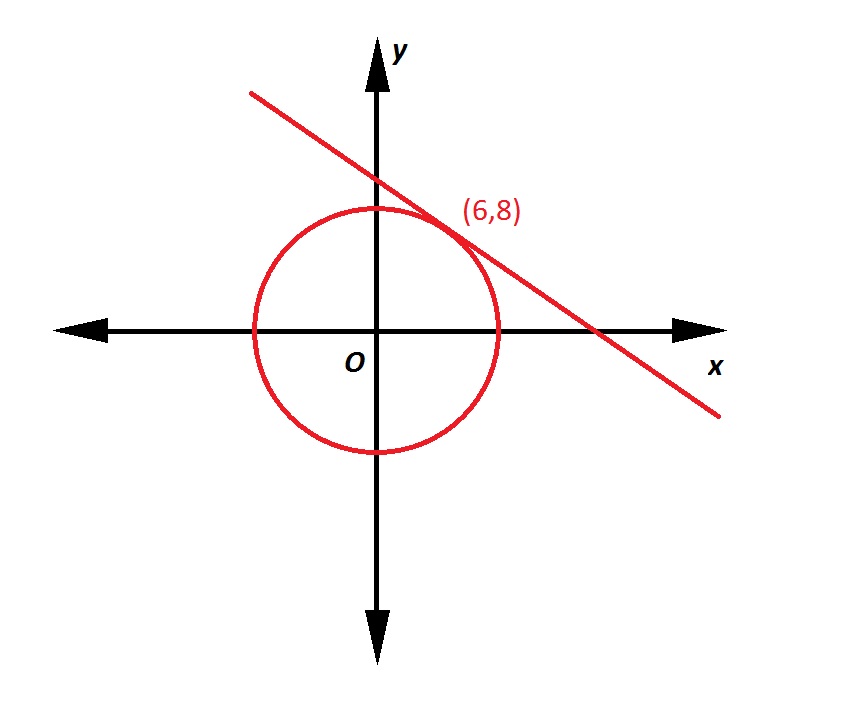Graphing Linear Functions
Help Questions
SAT Math › Graphing Linear Functions
Determine where the graphs of the following equations will intersect.
Explanation
We can solve the system of equations using the substitution method.
Solve for 
Substitute this value of 
Now we can solve for 
Solve for 

The solution is the ordered pair 

Which of the following inequalities is graphed above?
Explanation
First, we determine the equation of the boundary line. This line includes points 

Since we also know the 


The boundary is included, as is indicated by the line being solid, so the equality symbol is replaced by either 





0 is less than 3 so the correct symbol is 
The inequality is 

Which equation best matches the graph of the line shown above?
Explanation
To find an equation of a line, we will always need to know the slope of that line -- and to find the slope, we need at least two points. It looks like we have (0, -3) and (12,0), which we'll call point 1 and point 2, respectively.
Now we need to plug in a point on the line into an equation for a line. We can use either slope-intercept form or point-slope form, but since the answer choices are in point-slope form, let's use that.
Unfortunately, that's not one of the answer choices. That's because we didn't pick the same point to substitute into our equation as the answer choices did. But we can see if any of the answer choices are equivalent to what we found. Our equation is equal to:
which is the slope-intercept form of the line. We have to put all the other answer choices into slope-intercept to see if they match. The only one that works is this one:

Refer to the above diagram. If the red line passes through the point 

Explanation
One way to answer this is to first find the equation of the line.
The slope of a line. given two points 
Set 
The line has slope 3 and 


Now substitute 4 for 



An individual's maximum heart rate can be found by subtracting his or her age from 





Explanation
In 
We are looking for a graph with a slope of -1 and a y-intercept of 220.
The slope is -1 because as you grow one year older, your maximum heart rate decreases by 1.
Select the equation of the line perpendicular to the graph of 
None of these.
Explanation
Lines are perpendicular when their slopes are the negative recicprocals of each other such as 
Subtract the x variable from both sides:
Divide by 4 to isolate y:
The negative reciprocal of the above slope: 


Refer to the line in the above diagram. It we were to continue to draw it so that it intersects the 

Explanation
First, we need to find the slope of the line.
In order to move from the lower left point to the upper right point, it is necessary to move up five units and right three units. This is a rise of 5 and a run of 3. makes the slope of the line shown 
We can use this to find the 

The lower left point has coordinates 



Refer to the above red line. A line is drawn perpendicular to that line, and with the same 
Explanation
First, we need to find the slope of the above line.
The slope of a line. given two points 
Set 
The slope of a line perpendicular to it has as its slope the opposite of the reciprocal of 2, which would be 




Line 





The lines are parallel.
The lines are perpendicular.
The lines are identical.
The lines are distinct but neither parallel nor perpendicular.
Insufficient information is given to answer this question.
Explanation
We calculate the slopes of the lines using the slope formula.
The slope of line 
The slope of line 
The lines have the same slope, making them either parallel or identical.
Since the slope of each line is 0, both lines are horizontal, and the equation of each takes the form 







Note: Figure NOT drawn to scale.
Refer to the above figure. The circle has its center at the origin; the line is tangent to the circle at the point indicated. What is the equation of the line in slope-intercept form?
Insufficient information is given to determine the equation of the line.
Explanation
A line tangent to a circle at a given point is perpendicular to the radius from the center to that point. That radius, which has endpoints 

The line, being perpendicular to this radius, will have slope equal to the opposite of the reciprocal of that of the radius. This slope will be 































































































